Trade and International Business: FDI Trends and Economic Impacts
VerifiedAdded on 2023/01/13
|13
|2715
|84
Report
AI Summary
This report examines the evolving landscape of Foreign Direct Investment (FDI) and its impact on international trade, focusing on countries like the UK and Brazil. The report provides an overview of FDI, discussing its definition, importance, and the key factors driving it, while also differentiating it from portfolio investment. It delves into various FDI theories, including traditional, modern, and radical perspectives, such as capital arbitrage, product cycle, and electric theories, providing a comprehensive understanding of the theoretical underpinnings of FDI. Furthermore, the report presents a cost-benefit analysis of FDI, considering its impact on host countries and multinational corporations, and it provides data-driven insights into FDI trends in Brazil and the UK. Through trend analysis and comparative studies, the report aims to assess the current economic conditions influenced by FDI and to offer conclusions regarding the changing dynamics of international business and investment strategies.
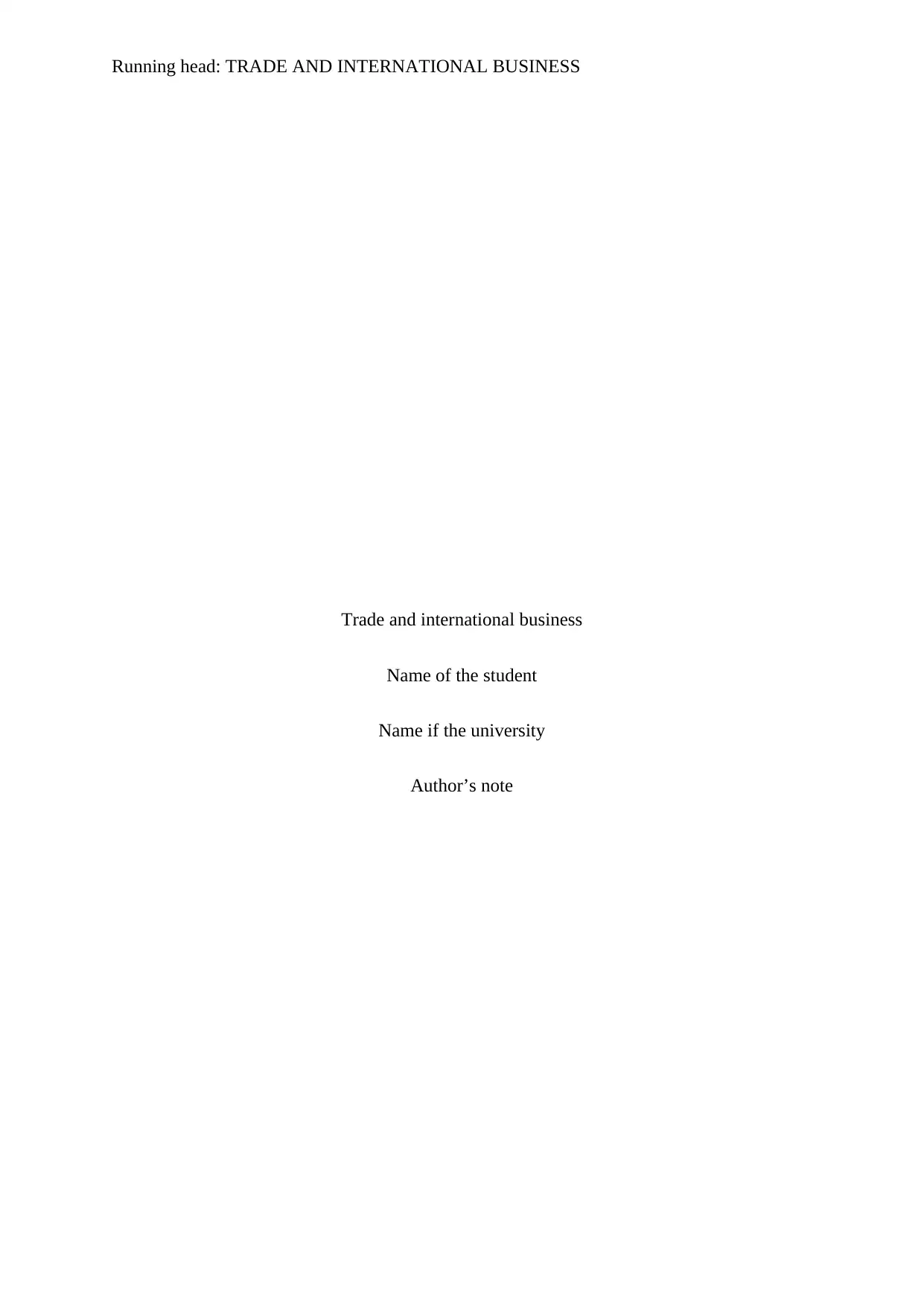
Running head: TRADE AND INTERNATIONAL BUSINESS
Trade and international business
Name of the student
Name if the university
Author’s note
Trade and international business
Name of the student
Name if the university
Author’s note
Paraphrase This Document
Need a fresh take? Get an instant paraphrase of this document with our AI Paraphraser
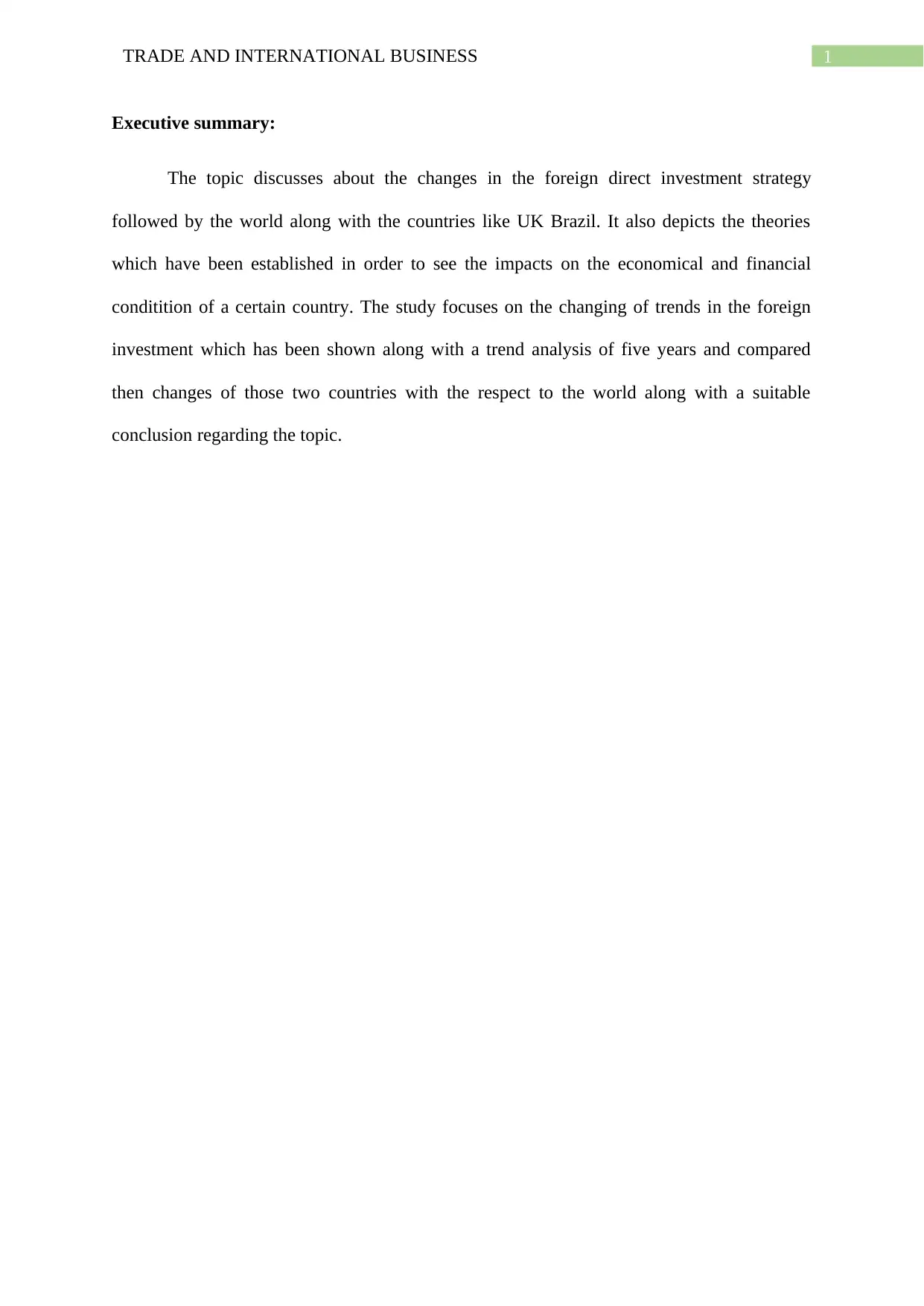
1TRADE AND INTERNATIONAL BUSINESS
Executive summary:
The topic discusses about the changes in the foreign direct investment strategy
followed by the world along with the countries like UK Brazil. It also depicts the theories
which have been established in order to see the impacts on the economical and financial
conditition of a certain country. The study focuses on the changing of trends in the foreign
investment which has been shown along with a trend analysis of five years and compared
then changes of those two countries with the respect to the world along with a suitable
conclusion regarding the topic.
Executive summary:
The topic discusses about the changes in the foreign direct investment strategy
followed by the world along with the countries like UK Brazil. It also depicts the theories
which have been established in order to see the impacts on the economical and financial
conditition of a certain country. The study focuses on the changing of trends in the foreign
investment which has been shown along with a trend analysis of five years and compared
then changes of those two countries with the respect to the world along with a suitable
conclusion regarding the topic.
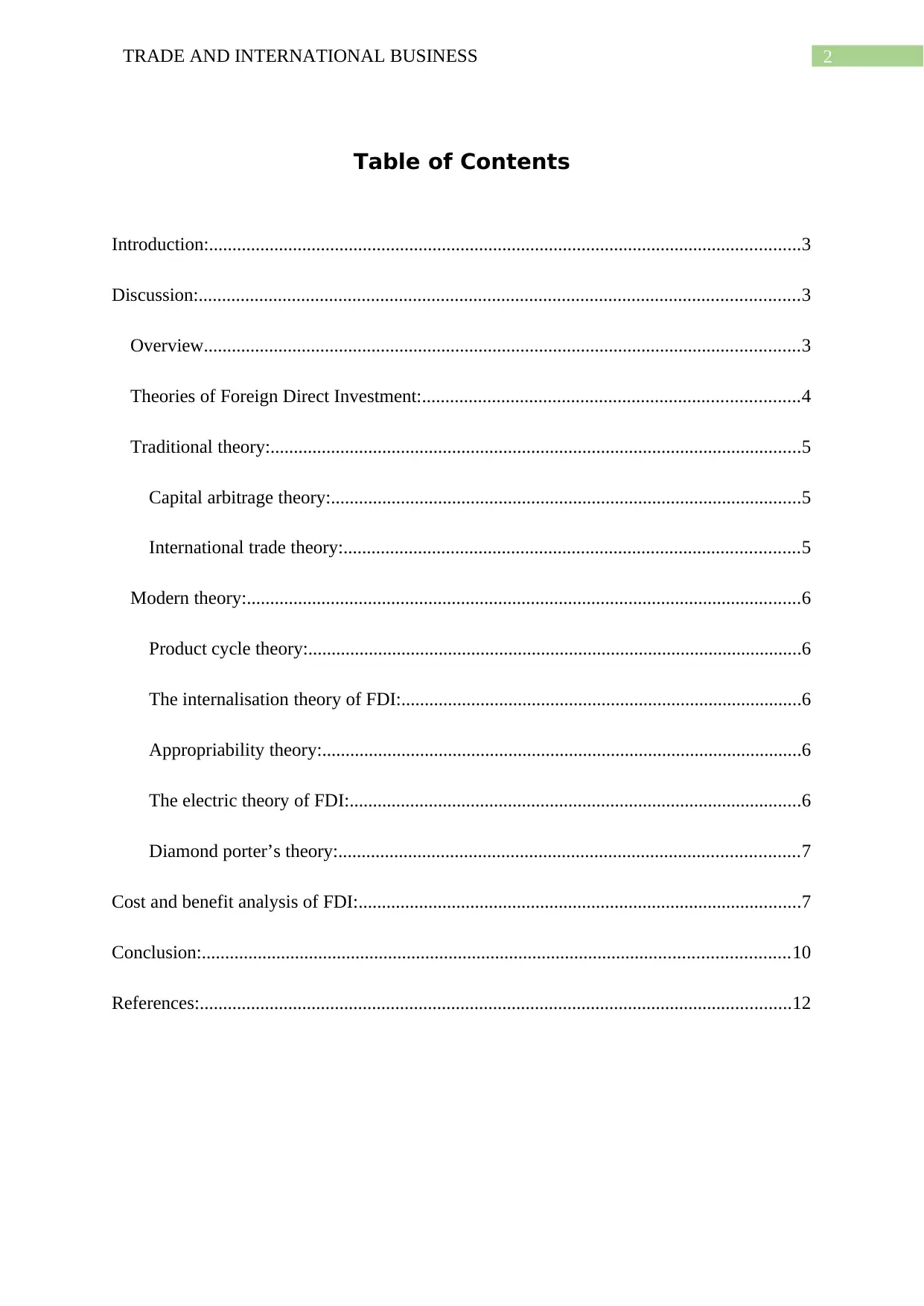
2TRADE AND INTERNATIONAL BUSINESS
Table of Contents
Introduction:...............................................................................................................................3
Discussion:.................................................................................................................................3
Overview................................................................................................................................3
Theories of Foreign Direct Investment:.................................................................................4
Traditional theory:..................................................................................................................5
Capital arbitrage theory:.....................................................................................................5
International trade theory:..................................................................................................5
Modern theory:.......................................................................................................................6
Product cycle theory:..........................................................................................................6
The internalisation theory of FDI:......................................................................................6
Appropriability theory:.......................................................................................................6
The electric theory of FDI:.................................................................................................6
Diamond porter’s theory:...................................................................................................7
Cost and benefit analysis of FDI:...............................................................................................7
Conclusion:..............................................................................................................................10
References:...............................................................................................................................12
Table of Contents
Introduction:...............................................................................................................................3
Discussion:.................................................................................................................................3
Overview................................................................................................................................3
Theories of Foreign Direct Investment:.................................................................................4
Traditional theory:..................................................................................................................5
Capital arbitrage theory:.....................................................................................................5
International trade theory:..................................................................................................5
Modern theory:.......................................................................................................................6
Product cycle theory:..........................................................................................................6
The internalisation theory of FDI:......................................................................................6
Appropriability theory:.......................................................................................................6
The electric theory of FDI:.................................................................................................6
Diamond porter’s theory:...................................................................................................7
Cost and benefit analysis of FDI:...............................................................................................7
Conclusion:..............................................................................................................................10
References:...............................................................................................................................12
⊘ This is a preview!⊘
Do you want full access?
Subscribe today to unlock all pages.

Trusted by 1+ million students worldwide
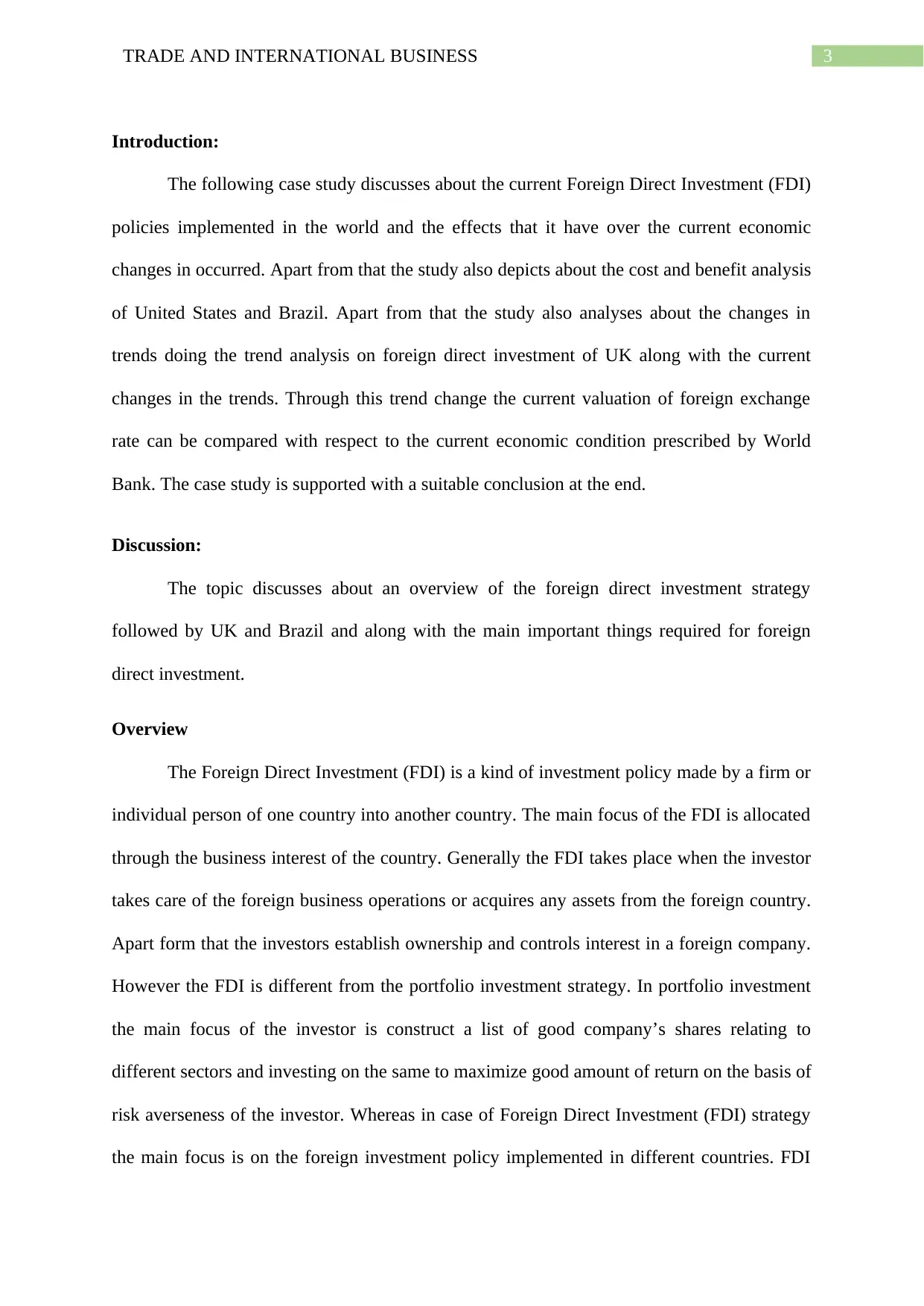
3TRADE AND INTERNATIONAL BUSINESS
Introduction:
The following case study discusses about the current Foreign Direct Investment (FDI)
policies implemented in the world and the effects that it have over the current economic
changes in occurred. Apart from that the study also depicts about the cost and benefit analysis
of United States and Brazil. Apart from that the study also analyses about the changes in
trends doing the trend analysis on foreign direct investment of UK along with the current
changes in the trends. Through this trend change the current valuation of foreign exchange
rate can be compared with respect to the current economic condition prescribed by World
Bank. The case study is supported with a suitable conclusion at the end.
Discussion:
The topic discusses about an overview of the foreign direct investment strategy
followed by UK and Brazil and along with the main important things required for foreign
direct investment.
Overview
The Foreign Direct Investment (FDI) is a kind of investment policy made by a firm or
individual person of one country into another country. The main focus of the FDI is allocated
through the business interest of the country. Generally the FDI takes place when the investor
takes care of the foreign business operations or acquires any assets from the foreign country.
Apart form that the investors establish ownership and controls interest in a foreign company.
However the FDI is different from the portfolio investment strategy. In portfolio investment
the main focus of the investor is construct a list of good company’s shares relating to
different sectors and investing on the same to maximize good amount of return on the basis of
risk averseness of the investor. Whereas in case of Foreign Direct Investment (FDI) strategy
the main focus is on the foreign investment policy implemented in different countries. FDI
Introduction:
The following case study discusses about the current Foreign Direct Investment (FDI)
policies implemented in the world and the effects that it have over the current economic
changes in occurred. Apart from that the study also depicts about the cost and benefit analysis
of United States and Brazil. Apart from that the study also analyses about the changes in
trends doing the trend analysis on foreign direct investment of UK along with the current
changes in the trends. Through this trend change the current valuation of foreign exchange
rate can be compared with respect to the current economic condition prescribed by World
Bank. The case study is supported with a suitable conclusion at the end.
Discussion:
The topic discusses about an overview of the foreign direct investment strategy
followed by UK and Brazil and along with the main important things required for foreign
direct investment.
Overview
The Foreign Direct Investment (FDI) is a kind of investment policy made by a firm or
individual person of one country into another country. The main focus of the FDI is allocated
through the business interest of the country. Generally the FDI takes place when the investor
takes care of the foreign business operations or acquires any assets from the foreign country.
Apart form that the investors establish ownership and controls interest in a foreign company.
However the FDI is different from the portfolio investment strategy. In portfolio investment
the main focus of the investor is construct a list of good company’s shares relating to
different sectors and investing on the same to maximize good amount of return on the basis of
risk averseness of the investor. Whereas in case of Foreign Direct Investment (FDI) strategy
the main focus is on the foreign investment policy implemented in different countries. FDI
Paraphrase This Document
Need a fresh take? Get an instant paraphrase of this document with our AI Paraphraser
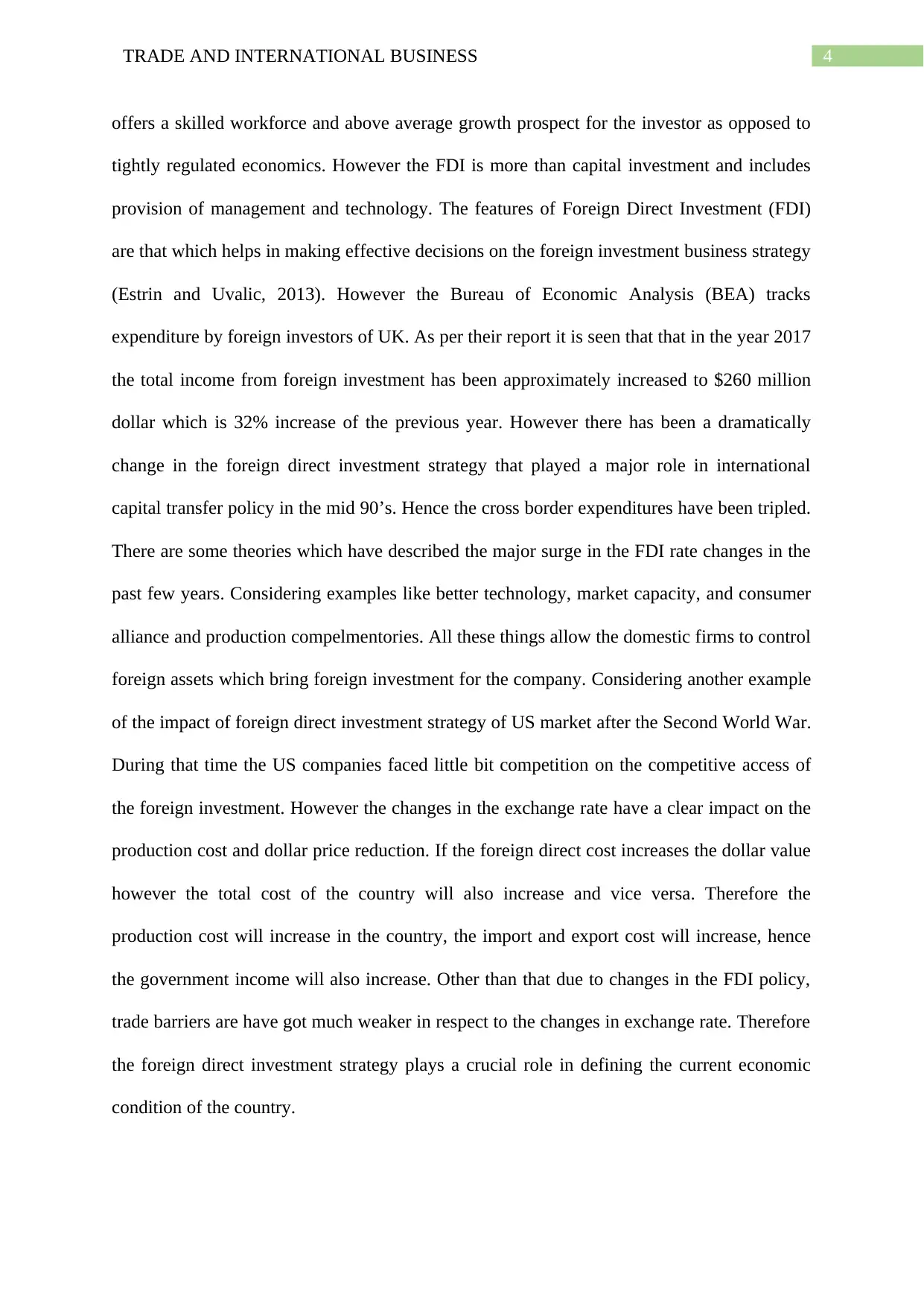
4TRADE AND INTERNATIONAL BUSINESS
offers a skilled workforce and above average growth prospect for the investor as opposed to
tightly regulated economics. However the FDI is more than capital investment and includes
provision of management and technology. The features of Foreign Direct Investment (FDI)
are that which helps in making effective decisions on the foreign investment business strategy
(Estrin and Uvalic, 2013). However the Bureau of Economic Analysis (BEA) tracks
expenditure by foreign investors of UK. As per their report it is seen that that in the year 2017
the total income from foreign investment has been approximately increased to $260 million
dollar which is 32% increase of the previous year. However there has been a dramatically
change in the foreign direct investment strategy that played a major role in international
capital transfer policy in the mid 90’s. Hence the cross border expenditures have been tripled.
There are some theories which have described the major surge in the FDI rate changes in the
past few years. Considering examples like better technology, market capacity, and consumer
alliance and production compelmentories. All these things allow the domestic firms to control
foreign assets which bring foreign investment for the company. Considering another example
of the impact of foreign direct investment strategy of US market after the Second World War.
During that time the US companies faced little bit competition on the competitive access of
the foreign investment. However the changes in the exchange rate have a clear impact on the
production cost and dollar price reduction. If the foreign direct cost increases the dollar value
however the total cost of the country will also increase and vice versa. Therefore the
production cost will increase in the country, the import and export cost will increase, hence
the government income will also increase. Other than that due to changes in the FDI policy,
trade barriers are have got much weaker in respect to the changes in exchange rate. Therefore
the foreign direct investment strategy plays a crucial role in defining the current economic
condition of the country.
offers a skilled workforce and above average growth prospect for the investor as opposed to
tightly regulated economics. However the FDI is more than capital investment and includes
provision of management and technology. The features of Foreign Direct Investment (FDI)
are that which helps in making effective decisions on the foreign investment business strategy
(Estrin and Uvalic, 2013). However the Bureau of Economic Analysis (BEA) tracks
expenditure by foreign investors of UK. As per their report it is seen that that in the year 2017
the total income from foreign investment has been approximately increased to $260 million
dollar which is 32% increase of the previous year. However there has been a dramatically
change in the foreign direct investment strategy that played a major role in international
capital transfer policy in the mid 90’s. Hence the cross border expenditures have been tripled.
There are some theories which have described the major surge in the FDI rate changes in the
past few years. Considering examples like better technology, market capacity, and consumer
alliance and production compelmentories. All these things allow the domestic firms to control
foreign assets which bring foreign investment for the company. Considering another example
of the impact of foreign direct investment strategy of US market after the Second World War.
During that time the US companies faced little bit competition on the competitive access of
the foreign investment. However the changes in the exchange rate have a clear impact on the
production cost and dollar price reduction. If the foreign direct cost increases the dollar value
however the total cost of the country will also increase and vice versa. Therefore the
production cost will increase in the country, the import and export cost will increase, hence
the government income will also increase. Other than that due to changes in the FDI policy,
trade barriers are have got much weaker in respect to the changes in exchange rate. Therefore
the foreign direct investment strategy plays a crucial role in defining the current economic
condition of the country.
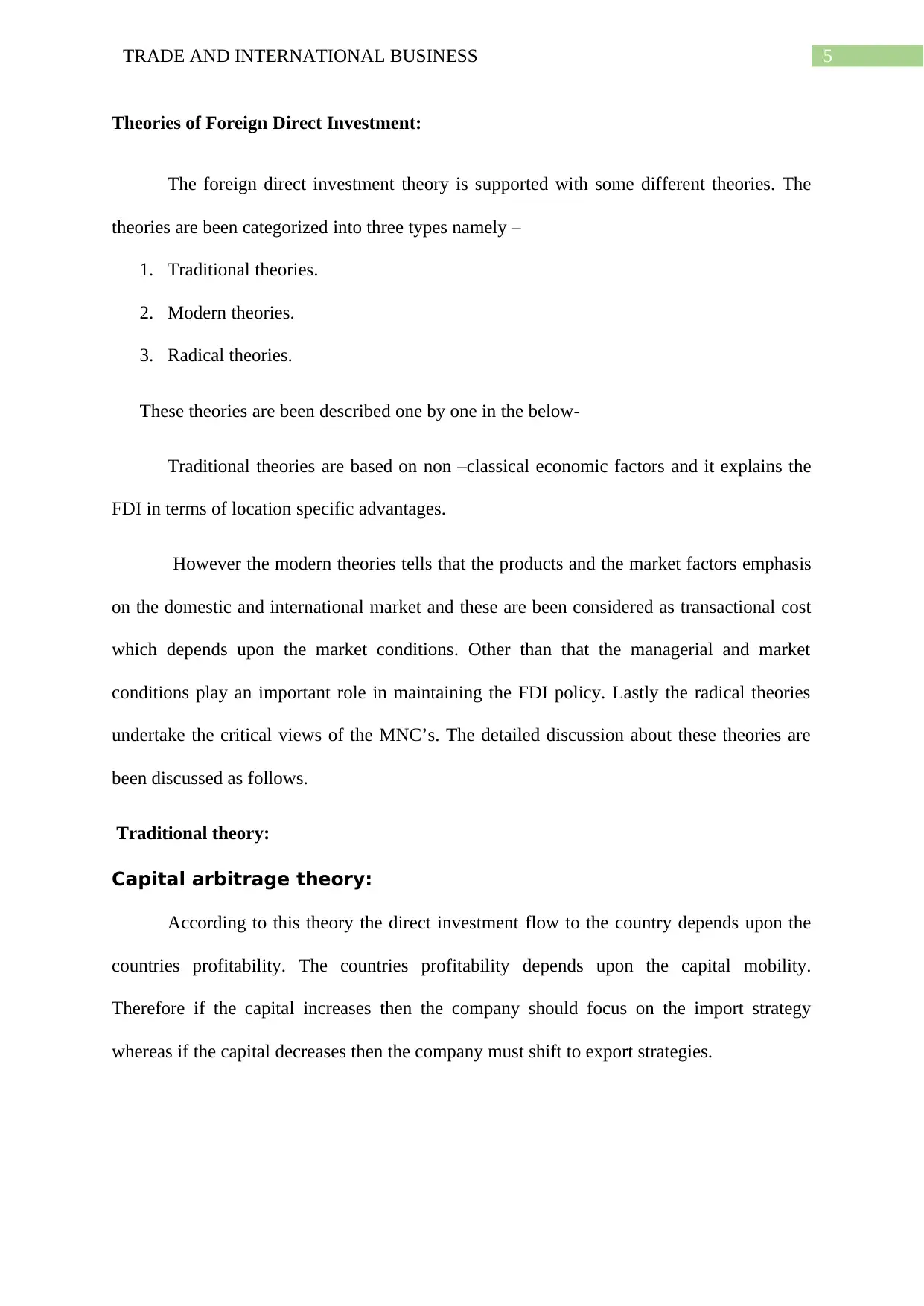
5TRADE AND INTERNATIONAL BUSINESS
Theories of Foreign Direct Investment:
The foreign direct investment theory is supported with some different theories. The
theories are been categorized into three types namely –
1. Traditional theories.
2. Modern theories.
3. Radical theories.
These theories are been described one by one in the below-
Traditional theories are based on non –classical economic factors and it explains the
FDI in terms of location specific advantages.
However the modern theories tells that the products and the market factors emphasis
on the domestic and international market and these are been considered as transactional cost
which depends upon the market conditions. Other than that the managerial and market
conditions play an important role in maintaining the FDI policy. Lastly the radical theories
undertake the critical views of the MNC’s. The detailed discussion about these theories are
been discussed as follows.
Traditional theory:
Capital arbitrage theory:
According to this theory the direct investment flow to the country depends upon the
countries profitability. The countries profitability depends upon the capital mobility.
Therefore if the capital increases then the company should focus on the import strategy
whereas if the capital decreases then the company must shift to export strategies.
Theories of Foreign Direct Investment:
The foreign direct investment theory is supported with some different theories. The
theories are been categorized into three types namely –
1. Traditional theories.
2. Modern theories.
3. Radical theories.
These theories are been described one by one in the below-
Traditional theories are based on non –classical economic factors and it explains the
FDI in terms of location specific advantages.
However the modern theories tells that the products and the market factors emphasis
on the domestic and international market and these are been considered as transactional cost
which depends upon the market conditions. Other than that the managerial and market
conditions play an important role in maintaining the FDI policy. Lastly the radical theories
undertake the critical views of the MNC’s. The detailed discussion about these theories are
been discussed as follows.
Traditional theory:
Capital arbitrage theory:
According to this theory the direct investment flow to the country depends upon the
countries profitability. The countries profitability depends upon the capital mobility.
Therefore if the capital increases then the company should focus on the import strategy
whereas if the capital decreases then the company must shift to export strategies.
⊘ This is a preview!⊘
Do you want full access?
Subscribe today to unlock all pages.

Trusted by 1+ million students worldwide
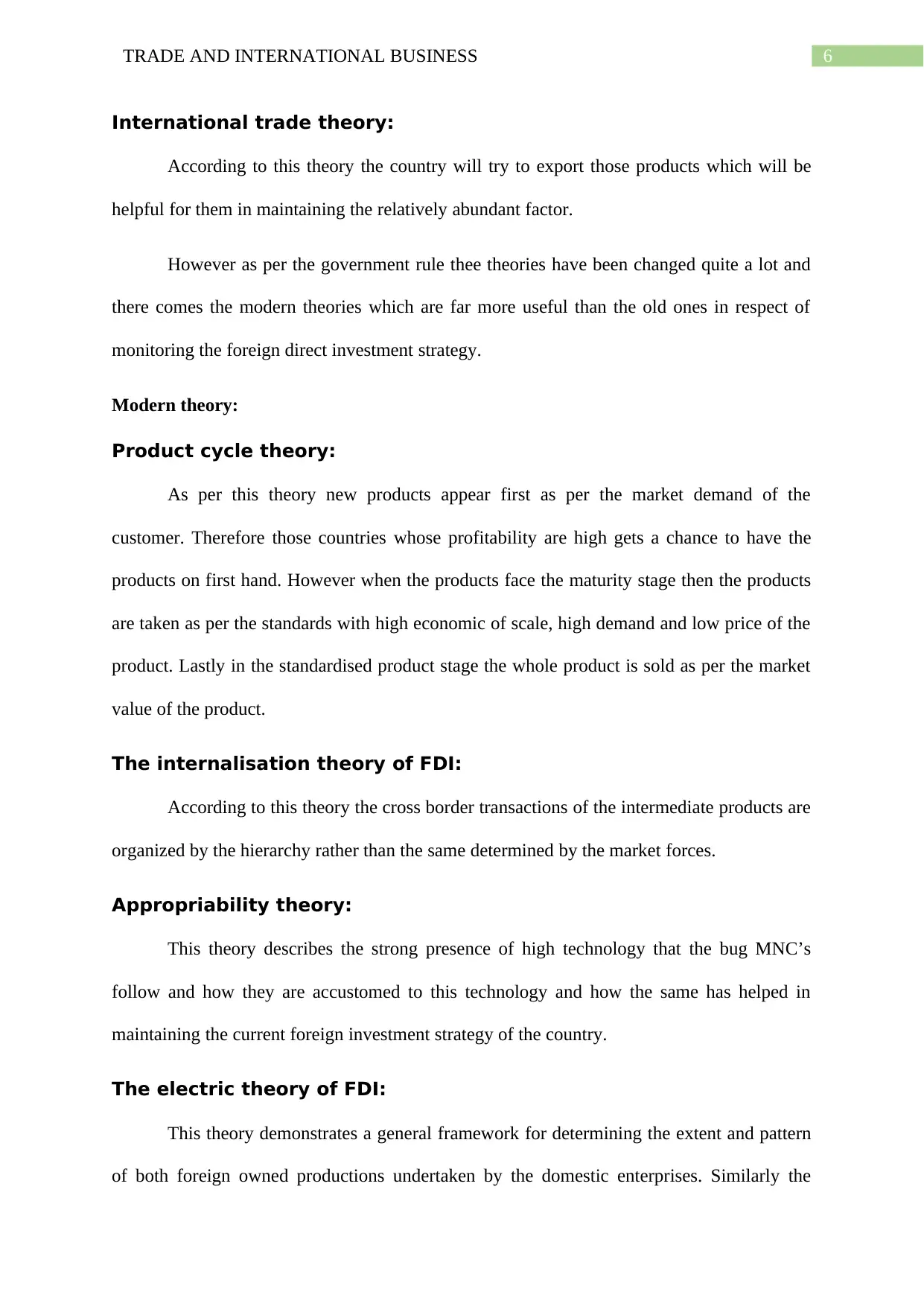
6TRADE AND INTERNATIONAL BUSINESS
International trade theory:
According to this theory the country will try to export those products which will be
helpful for them in maintaining the relatively abundant factor.
However as per the government rule thee theories have been changed quite a lot and
there comes the modern theories which are far more useful than the old ones in respect of
monitoring the foreign direct investment strategy.
Modern theory:
Product cycle theory:
As per this theory new products appear first as per the market demand of the
customer. Therefore those countries whose profitability are high gets a chance to have the
products on first hand. However when the products face the maturity stage then the products
are taken as per the standards with high economic of scale, high demand and low price of the
product. Lastly in the standardised product stage the whole product is sold as per the market
value of the product.
The internalisation theory of FDI:
According to this theory the cross border transactions of the intermediate products are
organized by the hierarchy rather than the same determined by the market forces.
Appropriability theory:
This theory describes the strong presence of high technology that the bug MNC’s
follow and how they are accustomed to this technology and how the same has helped in
maintaining the current foreign investment strategy of the country.
The electric theory of FDI:
This theory demonstrates a general framework for determining the extent and pattern
of both foreign owned productions undertaken by the domestic enterprises. Similarly the
International trade theory:
According to this theory the country will try to export those products which will be
helpful for them in maintaining the relatively abundant factor.
However as per the government rule thee theories have been changed quite a lot and
there comes the modern theories which are far more useful than the old ones in respect of
monitoring the foreign direct investment strategy.
Modern theory:
Product cycle theory:
As per this theory new products appear first as per the market demand of the
customer. Therefore those countries whose profitability are high gets a chance to have the
products on first hand. However when the products face the maturity stage then the products
are taken as per the standards with high economic of scale, high demand and low price of the
product. Lastly in the standardised product stage the whole product is sold as per the market
value of the product.
The internalisation theory of FDI:
According to this theory the cross border transactions of the intermediate products are
organized by the hierarchy rather than the same determined by the market forces.
Appropriability theory:
This theory describes the strong presence of high technology that the bug MNC’s
follow and how they are accustomed to this technology and how the same has helped in
maintaining the current foreign investment strategy of the country.
The electric theory of FDI:
This theory demonstrates a general framework for determining the extent and pattern
of both foreign owned productions undertaken by the domestic enterprises. Similarly the
Paraphrase This Document
Need a fresh take? Get an instant paraphrase of this document with our AI Paraphraser
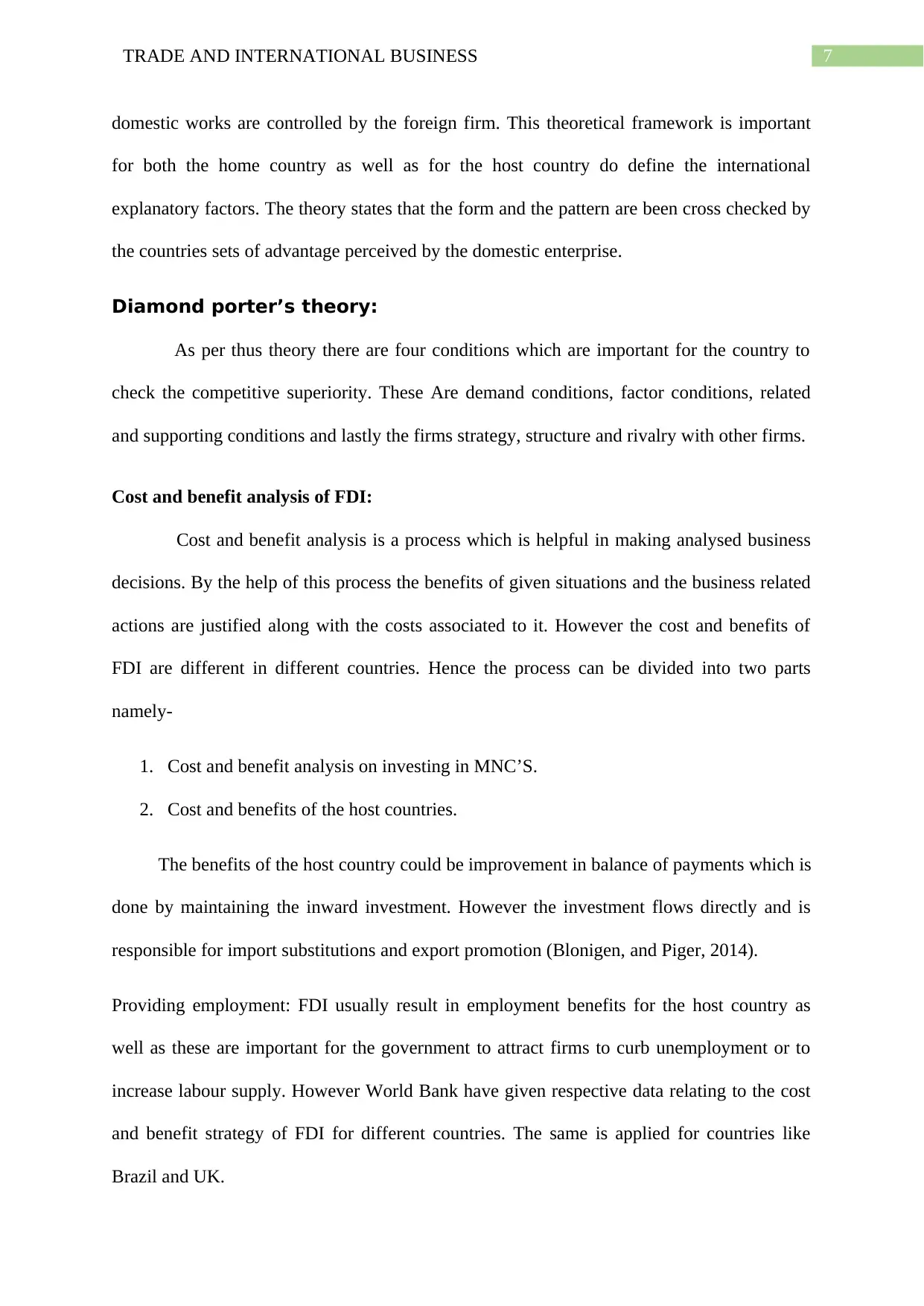
7TRADE AND INTERNATIONAL BUSINESS
domestic works are controlled by the foreign firm. This theoretical framework is important
for both the home country as well as for the host country do define the international
explanatory factors. The theory states that the form and the pattern are been cross checked by
the countries sets of advantage perceived by the domestic enterprise.
Diamond porter’s theory:
As per thus theory there are four conditions which are important for the country to
check the competitive superiority. These Are demand conditions, factor conditions, related
and supporting conditions and lastly the firms strategy, structure and rivalry with other firms.
Cost and benefit analysis of FDI:
Cost and benefit analysis is a process which is helpful in making analysed business
decisions. By the help of this process the benefits of given situations and the business related
actions are justified along with the costs associated to it. However the cost and benefits of
FDI are different in different countries. Hence the process can be divided into two parts
namely-
1. Cost and benefit analysis on investing in MNC’S.
2. Cost and benefits of the host countries.
The benefits of the host country could be improvement in balance of payments which is
done by maintaining the inward investment. However the investment flows directly and is
responsible for import substitutions and export promotion (Blonigen, and Piger, 2014).
Providing employment: FDI usually result in employment benefits for the host country as
well as these are important for the government to attract firms to curb unemployment or to
increase labour supply. However World Bank have given respective data relating to the cost
and benefit strategy of FDI for different countries. The same is applied for countries like
Brazil and UK.
domestic works are controlled by the foreign firm. This theoretical framework is important
for both the home country as well as for the host country do define the international
explanatory factors. The theory states that the form and the pattern are been cross checked by
the countries sets of advantage perceived by the domestic enterprise.
Diamond porter’s theory:
As per thus theory there are four conditions which are important for the country to
check the competitive superiority. These Are demand conditions, factor conditions, related
and supporting conditions and lastly the firms strategy, structure and rivalry with other firms.
Cost and benefit analysis of FDI:
Cost and benefit analysis is a process which is helpful in making analysed business
decisions. By the help of this process the benefits of given situations and the business related
actions are justified along with the costs associated to it. However the cost and benefits of
FDI are different in different countries. Hence the process can be divided into two parts
namely-
1. Cost and benefit analysis on investing in MNC’S.
2. Cost and benefits of the host countries.
The benefits of the host country could be improvement in balance of payments which is
done by maintaining the inward investment. However the investment flows directly and is
responsible for import substitutions and export promotion (Blonigen, and Piger, 2014).
Providing employment: FDI usually result in employment benefits for the host country as
well as these are important for the government to attract firms to curb unemployment or to
increase labour supply. However World Bank have given respective data relating to the cost
and benefit strategy of FDI for different countries. The same is applied for countries like
Brazil and UK.
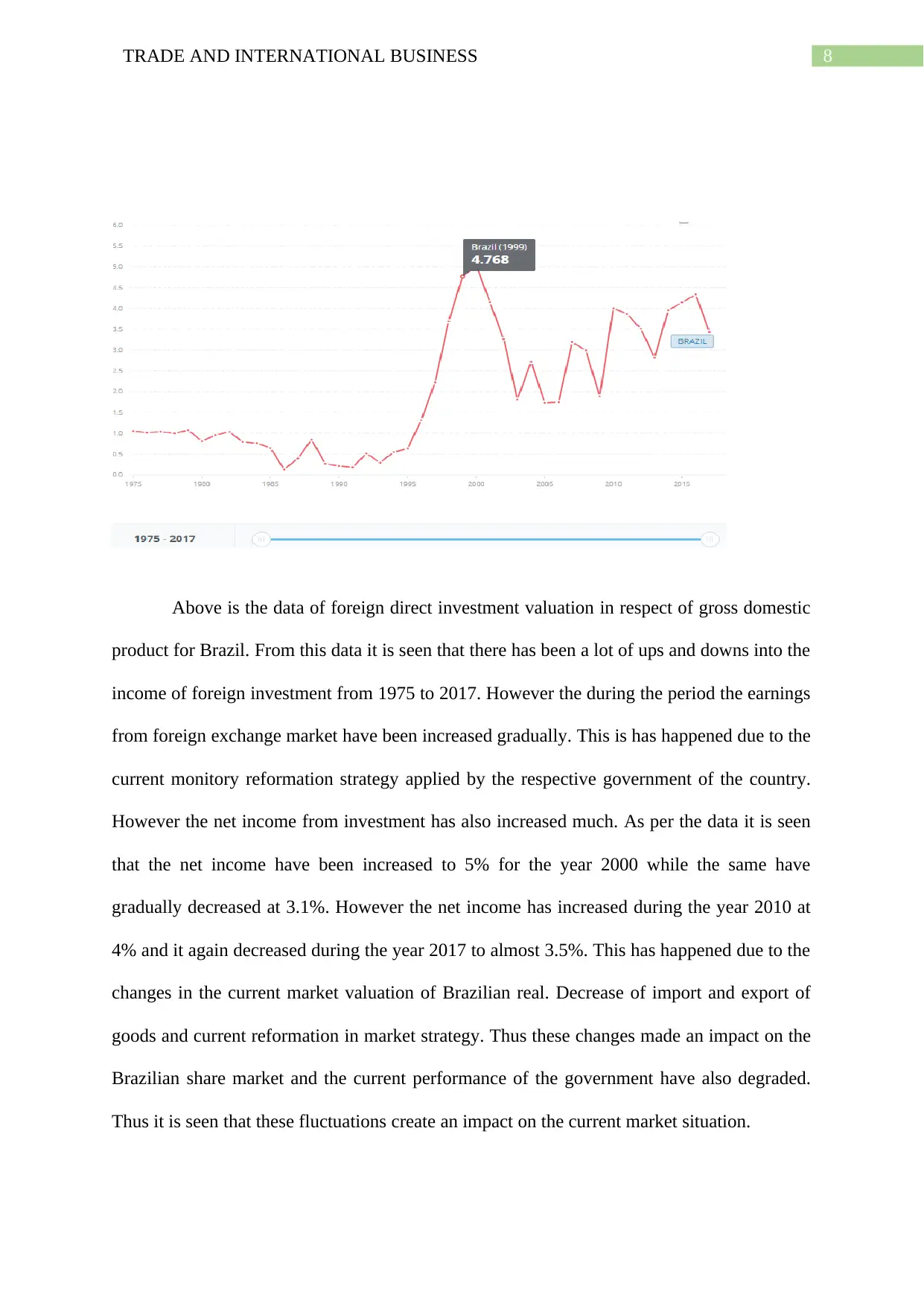
8TRADE AND INTERNATIONAL BUSINESS
Above is the data of foreign direct investment valuation in respect of gross domestic
product for Brazil. From this data it is seen that there has been a lot of ups and downs into the
income of foreign investment from 1975 to 2017. However the during the period the earnings
from foreign exchange market have been increased gradually. This is has happened due to the
current monitory reformation strategy applied by the respective government of the country.
However the net income from investment has also increased much. As per the data it is seen
that the net income have been increased to 5% for the year 2000 while the same have
gradually decreased at 3.1%. However the net income has increased during the year 2010 at
4% and it again decreased during the year 2017 to almost 3.5%. This has happened due to the
changes in the current market valuation of Brazilian real. Decrease of import and export of
goods and current reformation in market strategy. Thus these changes made an impact on the
Brazilian share market and the current performance of the government have also degraded.
Thus it is seen that these fluctuations create an impact on the current market situation.
Above is the data of foreign direct investment valuation in respect of gross domestic
product for Brazil. From this data it is seen that there has been a lot of ups and downs into the
income of foreign investment from 1975 to 2017. However the during the period the earnings
from foreign exchange market have been increased gradually. This is has happened due to the
current monitory reformation strategy applied by the respective government of the country.
However the net income from investment has also increased much. As per the data it is seen
that the net income have been increased to 5% for the year 2000 while the same have
gradually decreased at 3.1%. However the net income has increased during the year 2010 at
4% and it again decreased during the year 2017 to almost 3.5%. This has happened due to the
changes in the current market valuation of Brazilian real. Decrease of import and export of
goods and current reformation in market strategy. Thus these changes made an impact on the
Brazilian share market and the current performance of the government have also degraded.
Thus it is seen that these fluctuations create an impact on the current market situation.
⊘ This is a preview!⊘
Do you want full access?
Subscribe today to unlock all pages.

Trusted by 1+ million students worldwide
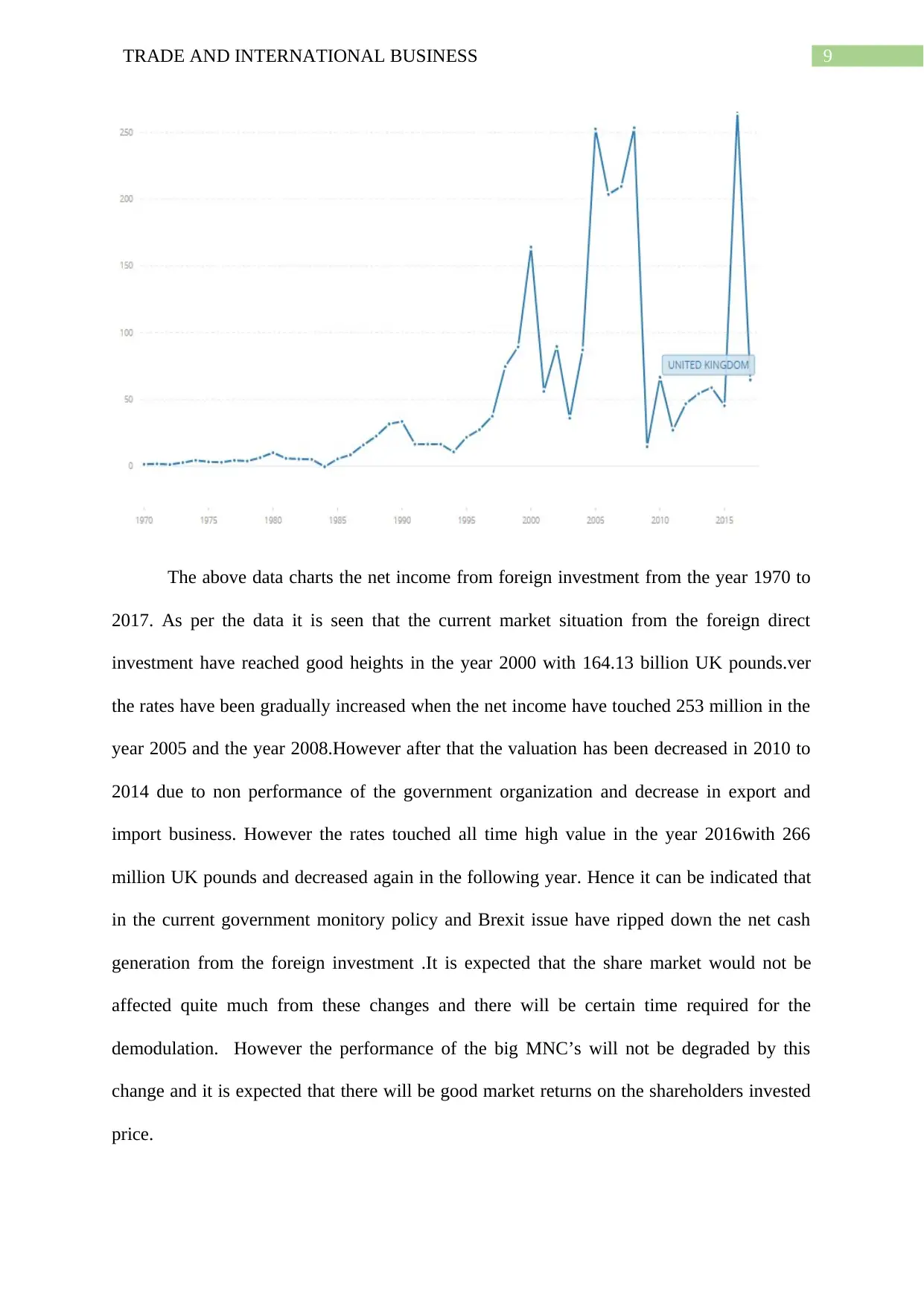
9TRADE AND INTERNATIONAL BUSINESS
The above data charts the net income from foreign investment from the year 1970 to
2017. As per the data it is seen that the current market situation from the foreign direct
investment have reached good heights in the year 2000 with 164.13 billion UK pounds.ver
the rates have been gradually increased when the net income have touched 253 million in the
year 2005 and the year 2008.However after that the valuation has been decreased in 2010 to
2014 due to non performance of the government organization and decrease in export and
import business. However the rates touched all time high value in the year 2016with 266
million UK pounds and decreased again in the following year. Hence it can be indicated that
in the current government monitory policy and Brexit issue have ripped down the net cash
generation from the foreign investment .It is expected that the share market would not be
affected quite much from these changes and there will be certain time required for the
demodulation. However the performance of the big MNC’s will not be degraded by this
change and it is expected that there will be good market returns on the shareholders invested
price.
The above data charts the net income from foreign investment from the year 1970 to
2017. As per the data it is seen that the current market situation from the foreign direct
investment have reached good heights in the year 2000 with 164.13 billion UK pounds.ver
the rates have been gradually increased when the net income have touched 253 million in the
year 2005 and the year 2008.However after that the valuation has been decreased in 2010 to
2014 due to non performance of the government organization and decrease in export and
import business. However the rates touched all time high value in the year 2016with 266
million UK pounds and decreased again in the following year. Hence it can be indicated that
in the current government monitory policy and Brexit issue have ripped down the net cash
generation from the foreign investment .It is expected that the share market would not be
affected quite much from these changes and there will be certain time required for the
demodulation. However the performance of the big MNC’s will not be degraded by this
change and it is expected that there will be good market returns on the shareholders invested
price.
Paraphrase This Document
Need a fresh take? Get an instant paraphrase of this document with our AI Paraphraser
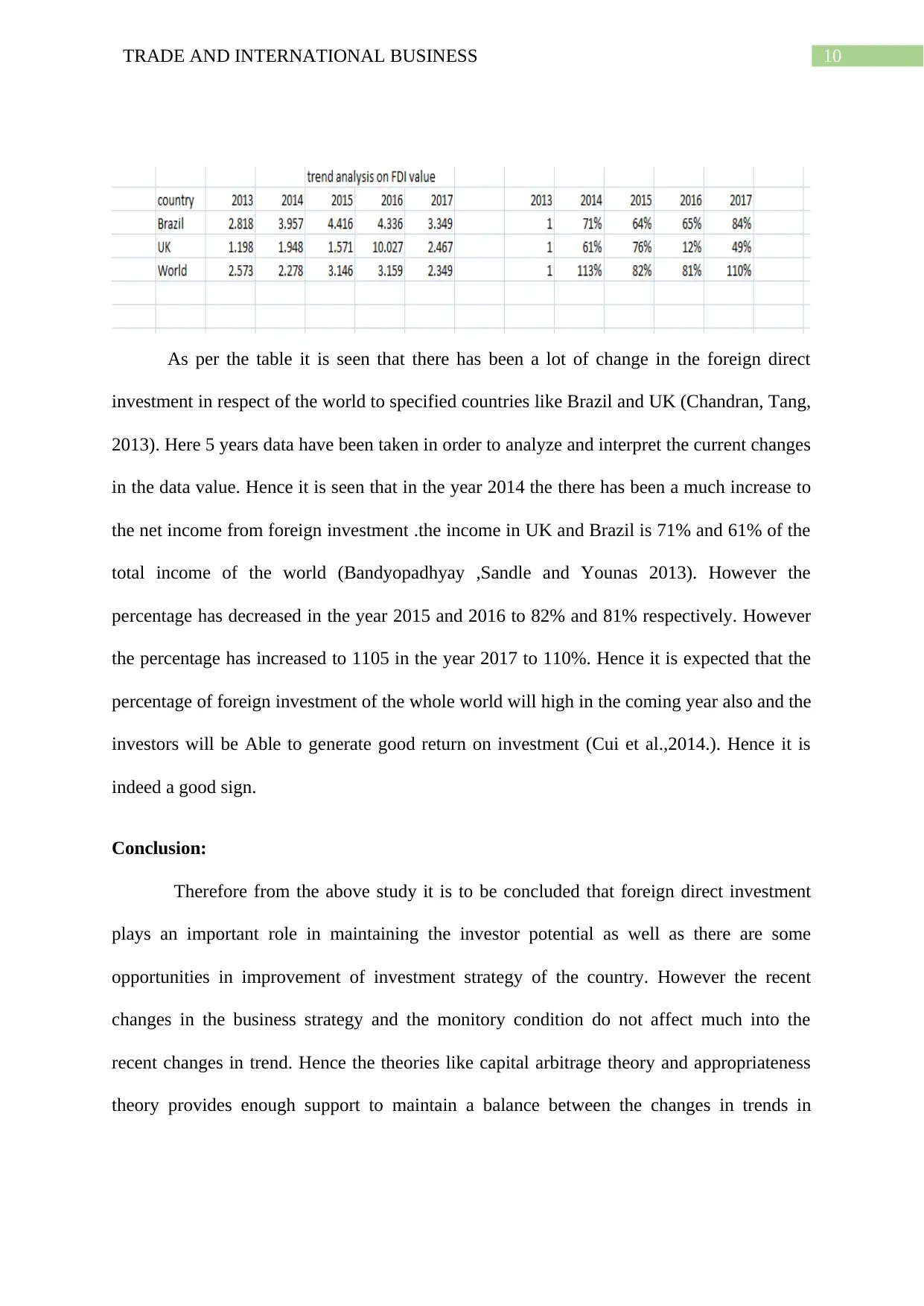
10TRADE AND INTERNATIONAL BUSINESS
As per the table it is seen that there has been a lot of change in the foreign direct
investment in respect of the world to specified countries like Brazil and UK (Chandran, Tang,
2013). Here 5 years data have been taken in order to analyze and interpret the current changes
in the data value. Hence it is seen that in the year 2014 the there has been a much increase to
the net income from foreign investment .the income in UK and Brazil is 71% and 61% of the
total income of the world (Bandyopadhyay ,Sandle and Younas 2013). However the
percentage has decreased in the year 2015 and 2016 to 82% and 81% respectively. However
the percentage has increased to 1105 in the year 2017 to 110%. Hence it is expected that the
percentage of foreign investment of the whole world will high in the coming year also and the
investors will be Able to generate good return on investment (Cui et al.,2014.). Hence it is
indeed a good sign.
Conclusion:
Therefore from the above study it is to be concluded that foreign direct investment
plays an important role in maintaining the investor potential as well as there are some
opportunities in improvement of investment strategy of the country. However the recent
changes in the business strategy and the monitory condition do not affect much into the
recent changes in trend. Hence the theories like capital arbitrage theory and appropriateness
theory provides enough support to maintain a balance between the changes in trends in
As per the table it is seen that there has been a lot of change in the foreign direct
investment in respect of the world to specified countries like Brazil and UK (Chandran, Tang,
2013). Here 5 years data have been taken in order to analyze and interpret the current changes
in the data value. Hence it is seen that in the year 2014 the there has been a much increase to
the net income from foreign investment .the income in UK and Brazil is 71% and 61% of the
total income of the world (Bandyopadhyay ,Sandle and Younas 2013). However the
percentage has decreased in the year 2015 and 2016 to 82% and 81% respectively. However
the percentage has increased to 1105 in the year 2017 to 110%. Hence it is expected that the
percentage of foreign investment of the whole world will high in the coming year also and the
investors will be Able to generate good return on investment (Cui et al.,2014.). Hence it is
indeed a good sign.
Conclusion:
Therefore from the above study it is to be concluded that foreign direct investment
plays an important role in maintaining the investor potential as well as there are some
opportunities in improvement of investment strategy of the country. However the recent
changes in the business strategy and the monitory condition do not affect much into the
recent changes in trend. Hence the theories like capital arbitrage theory and appropriateness
theory provides enough support to maintain a balance between the changes in trends in
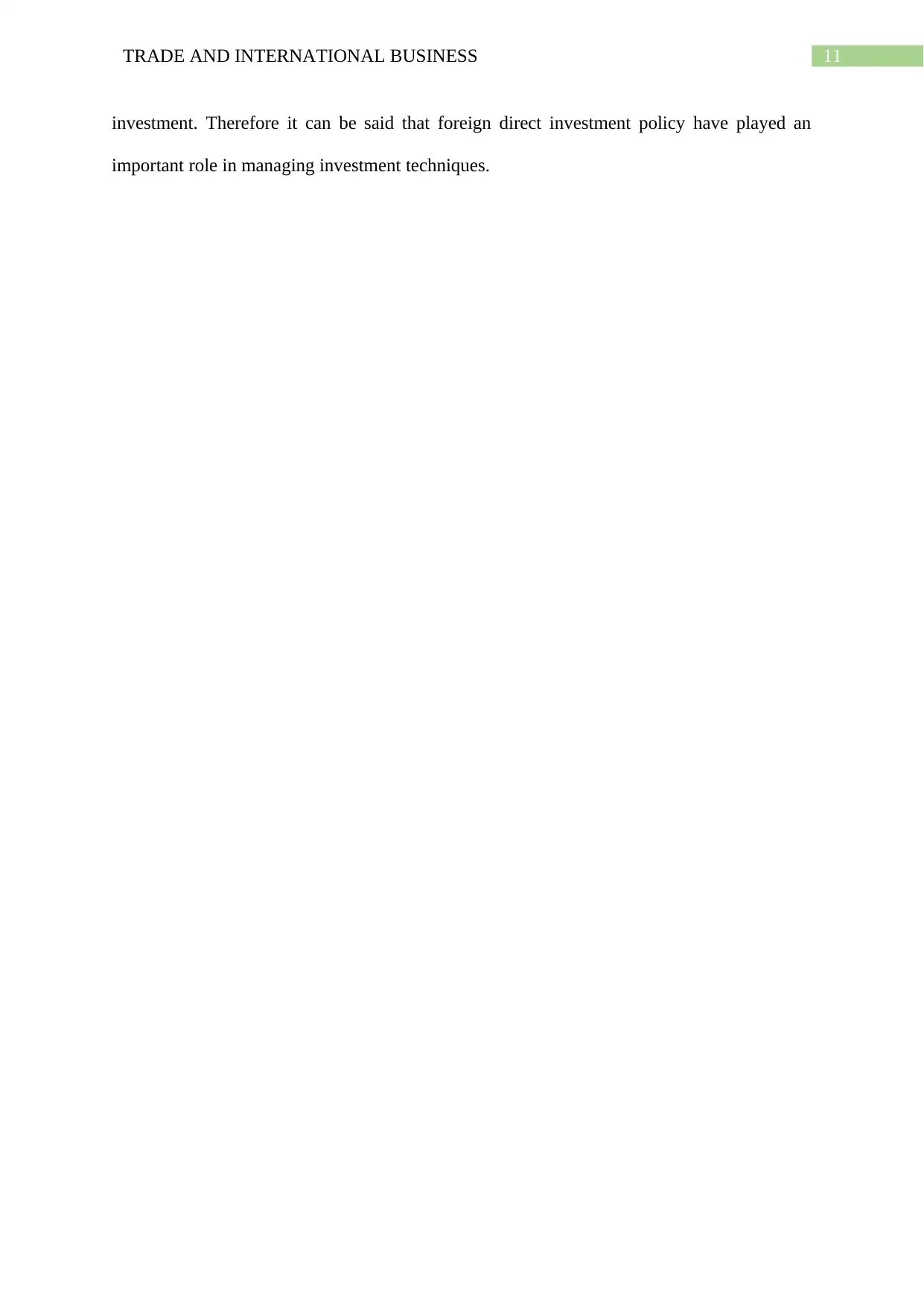
11TRADE AND INTERNATIONAL BUSINESS
investment. Therefore it can be said that foreign direct investment policy have played an
important role in managing investment techniques.
investment. Therefore it can be said that foreign direct investment policy have played an
important role in managing investment techniques.
⊘ This is a preview!⊘
Do you want full access?
Subscribe today to unlock all pages.

Trusted by 1+ million students worldwide
1 out of 13
Related Documents
Your All-in-One AI-Powered Toolkit for Academic Success.
+13062052269
info@desklib.com
Available 24*7 on WhatsApp / Email
![[object Object]](/_next/static/media/star-bottom.7253800d.svg)
Unlock your academic potential
Copyright © 2020–2025 A2Z Services. All Rights Reserved. Developed and managed by ZUCOL.





